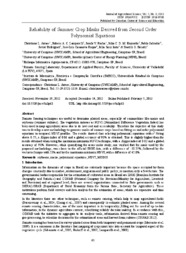Reliability of summer crop masks derived from second order polynomial equations.
Reliability of summer crop masks derived from second order polynomial equations.
Author(s): ARRAES, C. L.; LAMPARELLI, R. A. C.; ROCHA, J. V.; ESQUERDO, J. C. D. M.; SALVADOR, P.; RODRÍGUES, J.; ROQUE, J.-L. C.; JUSTO, J. S.; BENATTI, B. G.
Summary: Remote Sensing techniques are useful to determine planted areas, especially of commodities like maize and soybeans (summer cultures). The vegetation indexes as NDVI (Normalized Difference Vegetation Index) has been used to map agricultural areas due to its low cost and accessibility. Therefore the objective of this study was to develop a new methodology to generate masks of summer crops based on fitting second order polynomial equations to temporal NDVI profiles. The results showed that selecting polynomial equations with r2 fitting above 0.75, a Kappa index of 0.86 and a global accuracy of 93% is obtained. This is slightly higher than the results obtained when using the maximum-minimum NDVI technique, with a Kappa index of 0.82 and a global accuracy of 91%. However, while quantifying the areas under study, one verified that the mask used by the proposed methodology, was closer to the official IBGE data, with a difference of -10.25%, followed by the vector technique with 23% and by the maximum-minimum NDVI, with a difference of 42.8%.
Publication year: 2013
Types of publication: Journal article
Keywords: Corn, Milho, Remote sensing, Sensoriamento Remoto, Soja, Soybeans, Vegetation, Índice de vegetação
Observation
Some of Embrapa's publications are published as ePub files. To read them, use or download one of the following free software options to your computer or mobile device. Android: Google Play Books; IOS: iBooks; Windows and Linux: Calibre.
Access other publications
Access the Agricultural Research Database (BDPA) to consult Embrapa's full library collection and records.
Visit Embrapa Bookstore to purchase books and other publications sold by Embrapa.

